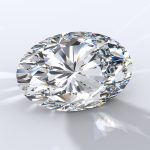Clear cut: Flat and transparent, the lasque is the very picture of elegant minimalism.
Is the portrait cut the diamond shape of 2024? While not as widespread as the pear shape or emerald cut, the portrait has charmed a new generation of designers and collectors who are drawn to its discreet, vintage-style appeal — especially amid the growing desire for distinctive engagement rings.
Is the portrait cut the diamond shape of 2024? While not as widespread as the pear shape or emerald cut, the portrait has charmed a new generation of designers and collectors who are drawn to its discreet, vintage-style appeal — especially amid the growing desire for distinctive engagement rings.
A glass from the past
The portrait cut, also called a lasque, is among the oldest forms of diamond cutting. Originating in ancient India, the style was a favorite of Mughal Emperor Shah Jahan, who built the legendary Taj Mahal in memory of his beloved wife Mumtaz Mahal. A visionary of jewelry as well as architecture, the emperor would commission thin, transparent diamonds to place over the hand-painted miniature portraits that figured in his jewels, as this helped protect them during wear.
The same technique would later gain traction in Europe as similar portrait jewelry became popular among royals and aristocrats.
Today, modern interpretations of the portrait cut are all the rage thanks to daring designers experimenting with unusual diamond shapes, from celebrity jeweler Lorraine Schwartz to Geneva-based maison Boghossian. At New York-based brand Eva Fehren, founder and creative director Eva Zuckerman has long championed the portrait cut for its refined minimalism, incorporating it into her pieces in hexagonal and trapezoidal shapes.
“I’ve always loved the understated elegance of a portrait-cut diamond,” she says. “The client who gravitates to it is someone who is looking for something unusual and nontraditional, but at the same time timeless and elegant.”
Her Cushion Eclat ring, which features a white portrait-cut diamond that appears to hover above the finger without a visible setting, has proven particularly popular, as has her Undercover ring, distinctive for its portrait-cut center diamond above a pavé-set gold “X,” which is visible through the stone.
“I’ve found that clients tend to have an immediate reaction to our portrait-cut pieces,” Zuckerman remarks. “Either they love them or they don’t, which makes selling them quite effortless.”
The price of frame
Collectors looking to snap up this appealing cut can expect to pay a high price for larger stones.
“These are still very niche items with very few dealers that are willing to stock them, so I would expect to pay a premium if you are looking for something special,” says Catherine Claus, founder of Thesis Gems in the San Francisco Bay area.
Her company specializes in ethical bespoke and limited-production jewelry. “Vintage and antique portrait cuts are extremely desirable and trade at decent premiums to traditional fancy cuts among those who are in the know.”
Claus has had little difficulty pitching the cut to clients; like Zuckerman, she observes that “the connection to the stone is instantly there, or it isn’t. I think the people who do love [portrait diamonds] appreciate the artistic side of how they are cut and manufactured. There really is no mass production of portrait cuts, and you very rarely ever see the same type of stone twice.”
Fast facts
Origins of the portrait cut: It’s believed that this cut originated in ancient India. Jewelers would use a tool that had two sets of angled facets, one on the top and one on the bottom. This allowed light to enter and reflect from both sides, creating a more lustrous sparkle than other diamond cuts.
How people have used it throughout history: A common use of the portrait cut over time has been as a protective cover for tiny paintings and portraits, particularly in jewelry. It was a favorite of Mughal Emperor Shah Jahan, who reigned in India between 1628 and 1658 and employed the cut for this purpose.
Famous jewels with portrait cuts: One of the most notable examples is actress Rooney Mara’s engagement ring from actor Joaquin Phoenix. The glittering yet understated design stars a hexagon-shaped portrait diamond in platinum, with slender tapered baguettes flanking it on either side.
BRON: Rapaport 02-04-2024




